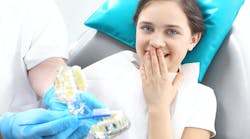Managing pediatric patients: 5 tips that work for dental hygienists
If you’re used to working with adults and move to a dental practice where you treat children, you’ll notice a unique set of challenges related to treating pediatric patients. These range from noncompliance to disruptive behavior and lack of ability to control impulses.
According to the American Academy of Pediatric Dentistry (AAPD), “The behaviors of the dentist and dental staff members are the primary tools used to guide the behavior of the pediatric patient” to guarantee a successful and stress-free visit.1 Rushing through the appointment, not explaining procedures, and being impatient will likely lead to unhappy patients and parents. In contrast, when a health-care provider demonstrates compassion, empathy, and genuine concern, there’s a greater chance for acceptance of care. Use these techniques to help you achieve excellent outcomes at pediatric hygiene visits.
You might also want to read
Using tell-show-do as a valuable tool for pediatric patients
Clinical tips: Intuitive patient care for pediatric dental patients
Build patient rapport
While building rapport is important in any patient interaction, it’s crucial when working with pediatric patients. Have a big smile and be very friendly. You can compliment them on something they’re wearing or ask them questions about school, vacation, a favorite toy, cartoons they like, and more.
Don’t be afraid to be silly; being overly serious might scare them. Try to create the sense that going to the dentist is exciting. You can tell them their teeth are going to be clean and shiny, or you can mention that they’ll get a toy before they leave (or a new toothbrush with a popular cartoon character).
Show-tell-do
Before you do anything, explain. Go over the steps of the procedure in an easy-to-understand way that avoids medical terms. Do not use words such as x-rays, suction, air/water syringe, rubber cup, or polishing paste. You can instead say pictures, Mr. Thirsty, water gun, spin brush, and special toothpaste.
For instance, before taking radiographs, show them the sensor and x-ray unit, and explain briefly what each one does. Tell them you’ll leave the room and press a button on the wall, there will be a beep, and then the “picture” is taken. Stress they need to keep biting down until the end of the beep. During the procedure, I like to show each tool and explain what it does, especially if it’s their first visit to the dentist.
Make the visit fun
As much as you can, make the visit enjoyable for the patient. Show them the fun dental chair that goes up and down (maybe let them push one of the buttons). Show them how Mr. Thirsty vacuums the water out of a cup. If they’re older and express interest in their surroundings, let them be your assistant and have them hold the suction. Let them choose their polishing paste flavor and if possible, offer different ones each time. Put cartoons on the television and watch how absorbed they become. Offer them a toothbrush with a super hero or a Disney princess so they look forward to brushing their teeth. Let them choose a small toy from a treasure chest at the end of the visit.
Ensure the patient is comfortable
Many dental tools and instruments are not made with pediatric patients in mind, particularly if you work in a general practice, so take some extra steps to ensure your young patients’ comfort. When taking radiographs, use a pediatric-size sensor and a minimalistic bite tab. You may have to use only the sensor and help the patient hold it in place while a coworker presses the exposure button (wear a lead vest for protection if you do this).
Provide a child booster seat if available (or a folded blanket or pillow) to help the child fit in the chair better, which will lead to more ergonomic operator positioning as well. Be gentle during instrumentation and take frequent breaks if needed. Hygiene scalers can look scary and are the exception to the show-tell-do rule. I usually do not let pediatric patients see scalers before they lay back and I sneak them in later.
Commend good behavior
Treat everything the child does as if it’s an amazing accomplishment and encourage them along the way. A dental cleaning might be routine to you, but to a five-year-old, it might be awkward or even frightening to let a stranger touch their mouth. Tell the child what a good job they’re doing when they open their mouth, follow instructions, sit calmly, and generally behave well.
In my experience, children want to please, so letting them know they’ve done well makes them eager to do what you ask. Even if something does not go according to plan, acknowledge that they complied with directions and deserve praise. Rewarding a patient for good behavior with a small toy goes a long way.
These techniques can be used to ensure pediatric patient compliance and a positive experience for everyone. Remember not to force patients to go beyond their level of comfort. If it’s a child’s first dental visit, you may be able to introduce them only to the environment and equipment and not complete any treatment.
The second visit, you or the dentist may be able to look at their teeth but not touch them. The next visit, the child may feel comfortable letting you polish their teeth. If the child is six and it’s time for radiographs, you may not be able to take those on the first try. Introduce them to the idea and the process and try next time (unless there’s a strong clinical need).
Evaluate the situation and act accordingly to avoid a negative experience that may impact future visits. These tips will help ensure a good experience for dental staff, patients, and parents.
Reference
1. Behavior guidance for the pediatric dental patient. The Reference Manual of Pediatric Dentistry. Chicago, Illinois. Latest revision 2020.
Anastassia Stoenelova, BA, RDH, has been in dentistry for 10 years. She currently practices clinically in Atlanta, Georgia. As a former ESL instructor, she is passionate about oral health education and making a difference in her patients' lives every day. She also works with Second Wind Dreams, a nonprofit organization that educates health-care professionals about dementia, and she is a personal recruiter for CUSP dental app. Contact her at [email protected].







